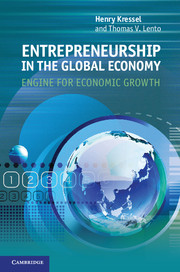Book contents
- Frontmatter
- Contents
- Figures
- Tables
- Acknowledgments
- Introduction
- 1 Government: Boss, financial partner, regulator – Entrepreneurs in mixed economies
- 2 Standing still is not an option: On promoting entrepreneurship and economic growth
- 3 Electronic innovation and the government: David Sarnoff creates the RCA empire
- 4 Global problem, golden opportunity: Ron Stanton profits from market disruption
- 5 Speeding voice and data traffic worldwide: Network microprocessors from RMI
- 6 A world leader emerges: SanDisk and flash memories
- 7 Implementing information technology across the globe
- 8 Three startups in China: Entrepreneurs in a controlled economy
- 9 Connecting the wireless networks of the world
- 10 Building an economy: Government planning vs. entrepreneurial innovation
- Select bibliography
- Index
4 - Global problem, golden opportunity: Ron Stanton profits from market disruption
Published online by Cambridge University Press: 05 August 2012
- Frontmatter
- Contents
- Figures
- Tables
- Acknowledgments
- Introduction
- 1 Government: Boss, financial partner, regulator – Entrepreneurs in mixed economies
- 2 Standing still is not an option: On promoting entrepreneurship and economic growth
- 3 Electronic innovation and the government: David Sarnoff creates the RCA empire
- 4 Global problem, golden opportunity: Ron Stanton profits from market disruption
- 5 Speeding voice and data traffic worldwide: Network microprocessors from RMI
- 6 A world leader emerges: SanDisk and flash memories
- 7 Implementing information technology across the globe
- 8 Three startups in China: Entrepreneurs in a controlled economy
- 9 Connecting the wireless networks of the world
- 10 Building an economy: Government planning vs. entrepreneurial innovation
- Select bibliography
- Index
Summary
I suppose I could have worked for someone else, but that wouldn’t have been fun.
Ron StantonUnlike the other entrepreneurs and innovative companies in this book, Ronald Stanton and Transammonia Inc. are not involved in a high-technology industry. While David Sarnoff, for example, built his electronics empire by envisioning markets that did not yet exist for technology still under development, Stanton achieved success by setting up an innovative but non-technical service company in a commodity industry.
Without doubt his business innovation has had a huge impact. Stanton started Transammonia, a company that trades in anhydrous ammonia, in 1965 with only $2,000 of equity capital. In 2008 it became the twenty-eighth largest private corporation in the US, with over $11 billion in revenues. It is the world leader in its sector, and has branched out into other commodity chemicals and liquid natural gas.
That is a remarkable achievement. But why do we include a commodity trading business in our study of global entrepreneurship when all our other cases focus on the high-technology electronics, computer, and communications companies that seem to dei ne our age? In a word, the reason is clarity. It is easy to be distracted by the glamour of the latest technology from appreciating the fundamentals of building an innovative business that creates lasting economic value. With Transammonia, there is no danger of that. Its history and well-dei ned business model embody the essentials of innovation and entrepreneurship.
- Type
- Chapter
- Information
- Entrepreneurship in the Global EconomyEngine for Economic Growth, pp. 116 - 130Publisher: Cambridge University PressPrint publication year: 2012



